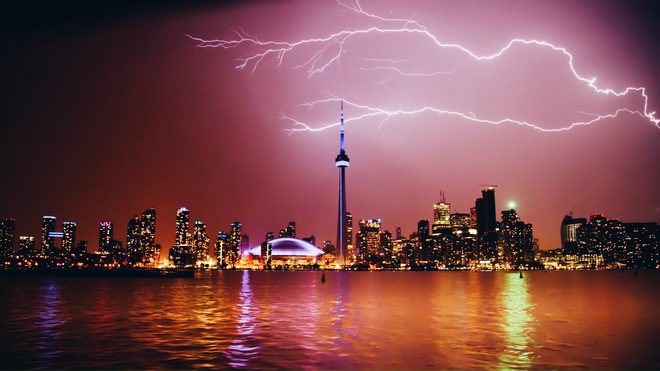
Lightning above the Toronto skyline. (Courtesy: The Weather Network)
By Sarah Watson
As thunder storm season begins, so does Lightning Safety Awareness Week, with Environment Canada warning people to take shelter when bad weather rolls in.
June 12-18 is #LightningSafety Week! When #thunder roars, GO INDOORS! ?️ https://t.co/bPZj0lu6pQ pic.twitter.com/0CI3aPfI4K
— Environment Canada (@environmentca) June 12, 2017
“People commonly wait until it starts raining to take shelter and the problem is there is a large percentage of injuries that occur before the rain begins and after the rain is over,” said Peter Kimbell, a warning preparedness meteorologist of Environment and Climate Change Canada, “So as soon as you can hear thunder, you’re at risk of being struck.”
Kimbell also advises staying inside until 30 minutes after the last rumble of thunder.
The best shelters for lightning protection, Kimbell said, are buildings with wiring or plumbing, or in vehicles.
“The wiring or the plumbing in the house is what protects you,” said Kimbell, citing the way they conduct the electricity from the strike.
For this reason, Kimbell said, “you also don’t want to be touching the wiring or the plumbing. You don’t want to be holding onto the sink, for example. You don’t want to be holding a corded phone.”
Similarly, it’s the metal shell of a car or truck that protects against lightning, not the rubber tires as in the common misperception.
The number one activity related to lightning deaths and injuries is camping or hiking, according to an Environment and Climate Change Canada study that looked at incidents in Canada from 1986 to 2005, with boating, picnics and golfing common contexts as well. In such cases, people may not have access to electricity-conducting shelter.
If outside, without an accessible car or building, Kimbell said, “there’s no guarantees of safety,” but there are ways to reduce the risk of lightning inflicted injury.
“You can avoid putting yourself at the highest point nearby. So if you can find low lying area such as valleys or ditches or depressions, try to go there,” Kimbell said.
Environment Canada also recommends staying away from bodies of water such as lakes, and tall objects such as trees, poles or fences.
“And stay away from objects that conduct electricity like tractors, golf carts,” Kimbell said.
If someone is struck by lightning, they should receive immediate medical attention, and CPR may be necessary.
Environment Canada says that approximately 10 people in Canada die from lightning every year, with another 100 to 150 injured. Kimbell said those numbers are likely higher than current reality, as fatalities have decreased in recent years.
“I think what it proves is that our safety messaging is having a positive effect,” Kimbell said.
Lightning Safety Awareness Week goes from June 12 to 18.
https://magic.piktochart.com/output/23028990-lightning

